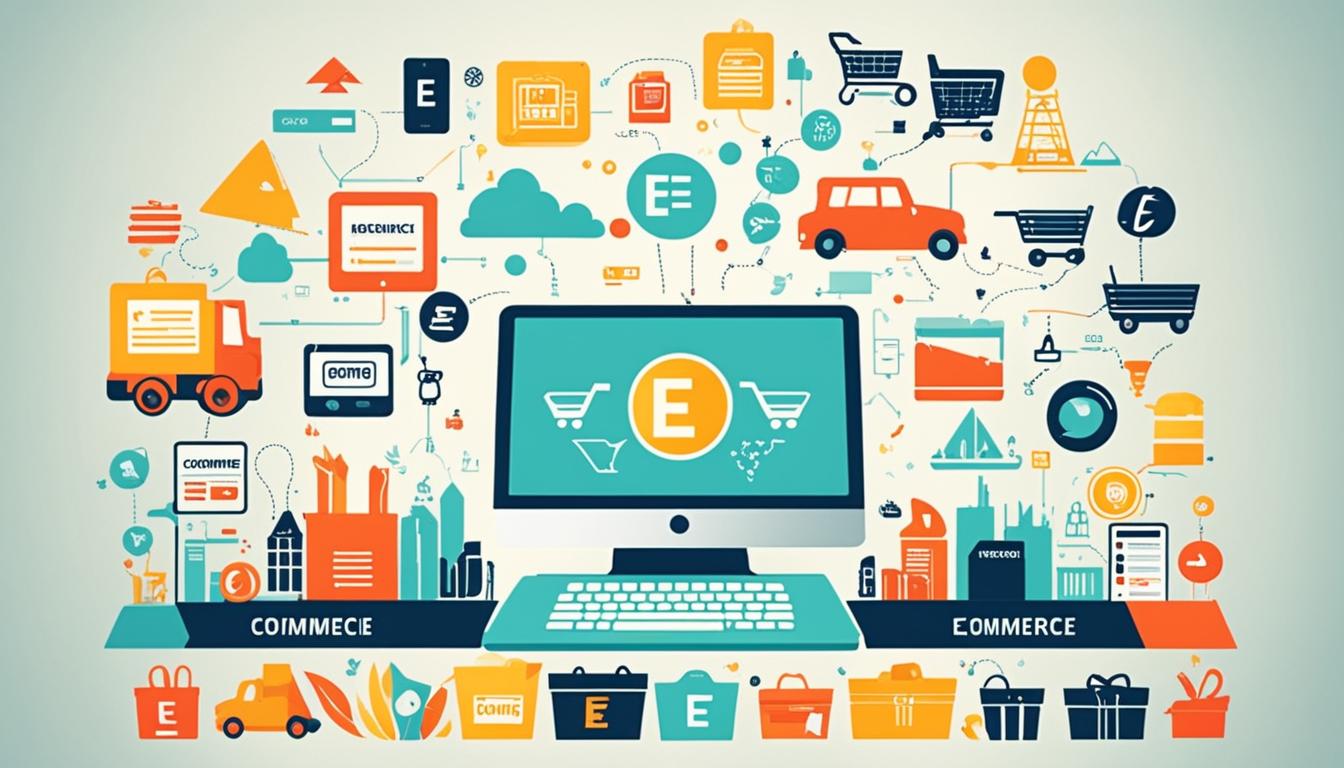How To Start an Ecommerce Business From Scratch In 2024
Did you know that the global ecommerce market is projected to reach a staggering $6.5 trillion in sales by 2023? With the rapid growth of online shopping, starting an ecommerce business has become an incredibly lucrative opportunity. If you’ve ever dreamed of launching your own online store and tapping into this thriving market, now is the perfect time to do so.
In this ecommerce business startup guide, I will walk you through the step-by-step process of building a successful online business from scratch. From valuable tips on starting an online store and building an ecommerce website to creating an effective e-commerce business plan and implementing powerful ecommerce marketing tactics, you’ll have all the tools and knowledge you need to launch your own ecommerce venture in 2024.
Key Takeaways:
- Starting an ecommerce business in 2024 offers immense potential for success due to the thriving global ecommerce market.
- By following the step-by-step process outlined in this guide, you can build a profitable online store from scratch.
- Key areas to focus on include setting up an ecommerce website, writing a comprehensive business plan, and implementing effective ecommerce marketing tactics.
- Make sure to stay updated on the latest ecommerce trends and consumer behaviors to ensure long-term success.
- Remember, starting an online store is an exciting and rewarding journey, so embrace the opportunity and turn your ecommerce dreams into reality!
Finding Product Opportunities and Choosing What to Sell
Before starting an ecommerce business, it’s essential to find the right product to sell. This section will guide you through the process of finding product opportunities and choosing what to sell. By researching your competition, validating your product ideas, and determining the best method for obtaining your products, you’ll make informed decisions about your product offerings.
Researching your competition is crucial. It helps you understand the market and identify the gap you can fill with your product. Look at the existing ecommerce stores, marketplaces, and social media platforms to see what products are popular and identify any underserved niches.
Validation is key to ensure there is demand for your product. Conduct market research, surveys, and gather feedback from potential customers. Consider utilizing online tools and platforms to validate your product ideas before investing time and money.
Obtaining products can be done through various methods. You can choose to sell retail products online, where you purchase inventory from suppliers and manage the shipping and fulfillment process yourself. Another option is to explore dropshipping, where you partner with suppliers who handle the shipping for you. You can also consider print on demand, which allows you to create custom products without keeping inventory.
When choosing what to sell, consider your passion, expertise, and target audience. Find a product that aligns with your interests, as it will make it easier for you to market and sell. Consider the profitability, market demand, and competition level when making your decision.
Example: Finding Product Opportunities Checklist
| Steps | Description |
|---|---|
| Research competition | Identify existing ecommerce stores and marketplaces to understand popular products and underserved niches. |
| Validate product ideas | Conduct market research, surveys, and gather feedback from potential customers to ensure there is demand for your product. |
| Choose sourcing method | Determine whether you will sell retail products online, explore dropshipping, or consider print on demand. |
| Consider passion and expertise | Choose a product that aligns with your interests, making it easier for you to market and sell. |
| Assess profitability and competition | Evaluate the potential profitability of the product and the level of competition in the market. |
Writing a Business Plan and Setting Up Your Online Store
Now that you have your product ideas and sourcing methods in place, it’s time to write a business plan and set up your online store. This section will guide you through the process of creating a comprehensive business plan that outlines your objectives and strategies.
Writing a business plan is crucial as it helps you map out your goals and define the steps needed to achieve them. It provides a roadmap for your ecommerce business, allowing you to stay focused and make informed decisions.
Choosing a Business Name and Designing a Logo
- When choosing a business name, it’s important to consider a name that is memorable, reflects your brand identity, and is easy to spell and pronounce.
- Designing a logo is another crucial step in establishing your brand identity. A well-designed logo can help build brand recognition and set your online store apart from the competition.
Take the time to brainstorm creative business names and design a logo that resonates with your target audience. Remember, your business name and logo should align with your brand values and the products you offer.
Understanding SEO and Building Your Store
Search Engine Optimization (SEO) plays a vital role in driving organic traffic to your online store. It involves optimizing your website and product pages to rank higher in search engine results.
When building your store, it’s important to prioritize SEO best practices. This includes optimizing your product titles, descriptions, and meta tags with relevant keywords that your target audience is searching for.
Additionally, ensure that your website is user-friendly, with easy navigation and a responsive design that adapts to different devices. A well-designed and optimized store enhances the overall user experience, increasing the chances of customer engagement and conversion.
Choosing Sales Channels
When it comes to selling your products online, there are various sales channels to consider. You can choose to sell on your own website, marketplaces like Amazon or eBay, or even social media platforms.
Each sales channel has its own advantages and considerations. Consider your target audience, competition, and cost implications when choosing the right sales channels for your business. It’s often beneficial to start with a few channels and expand as your online store grows.
By carefully selecting your sales channels, you can reach a wider audience and increase your chances of sales and success.
Choosing Your Shipping Strategy and Setting Sales and Marketing Goals
As you near the launch of your ecommerce business, it’s crucial to choose a shipping strategy and set sales and marketing goals. These decisions will have a significant impact on the success of your business and the satisfaction of your customers. To help you make informed choices, consider the following factors:
1. Ecommerce Shipping and Fulfillment
When it comes to ecommerce shipping and fulfillment, you have several options to consider. You can choose to handle shipping in-house, work with a fulfillment center, or explore dropshipping. Each option has its pros and cons, so carefully evaluate which one aligns with your business model and resources.
2. International Shipping
If you plan to expand your customer base globally, international shipping is essential. Research the regulations, customs procedures, and shipping costs of different countries. Consider working with international shipping carriers or utilizing international shipping platforms to simplify the process.
3. Reducing Shipping Costs
Shipping costs can eat into your profits, so it’s crucial to find ways to reduce them. Negotiate shipping rates with carriers, optimize your packaging to minimize dimensional weight charges, and consider offering free shipping thresholds to encourage larger orders.
4. Setting Sales and Marketing Goals
Before launching your ecommerce business, set specific sales and marketing goals. These goals will guide your actions and help measure your success. Determine your target revenue, customer acquisition targets, and key performance indicators (KPIs) to track your progress.
5. Store Launch Checklist
Finally, ensure that all essential tasks are completed before your business goes live. Use a store launch checklist to make sure you’ve covered everything, from testing your website’s functionality and user experience to setting up analytics and implementing marketing campaigns.
| Shipping Strategy | Pros | Cons |
|---|---|---|
| In-house Shipping | Greater control over shipping process | Requires additional resources and manpower |
| Fulfillment Center | Outsource shipping and fulfillment tasks | Lack of immediate control over shipping process |
| Dropshipping | No upfront inventory costs | Potential for lower profit margins |
By carefully considering your shipping strategy and setting clear sales and marketing goals, you’ll be well-prepared for a successful ecommerce business launch. Remember to continuously evaluate and refine your approach as your business grows and evolves.

Acquiring Your First Customer and Marketing Your Store
Now that your ecommerce business is up and running, it’s time to focus on acquiring your first customer and implementing effective marketing strategies. In this section, I’ll share tactics that you can use to get your first sale, drive targeted traffic to your store, and effectively market your products to attract customers.
One of the key strategies for acquiring your first customer is email marketing. By building an email list, you can directly reach out to potential customers and share updates and promotions about your store. Craft compelling email campaigns that highlight your unique selling propositions and create a sense of urgency to encourage customers to make their first purchase.
Social media marketing is another powerful tool for driving targeted traffic to your store. Create engaging content that resonates with your target audience and use social media platforms like Facebook, Instagram, and Twitter to promote your products. By leveraging hashtags, influencers, and user-generated content, you can expand your reach and attract potential customers.
Paid advertising is another effective way to reach a wider audience and drive traffic to your store. Platforms like Google Ads and Facebook Ads allow you to target specific demographics and interests, ensuring that your ads are shown to potential customers who are more likely to convert. Develop compelling ad creatives and optimize your campaigns to maximize your return on investment.
Additionally, implementing conversion rate optimization (CRO) techniques is crucial for improving your website’s ability to convert visitors into customers. Conduct A/B testing to optimize your website’s design, layout, and call-to-action buttons. By analyzing user behavior and making data-driven changes, you can increase your conversion rates and generate more sales.

| Marketing Strategy | Benefits |
|---|---|
| Email Marketing | Directly reach potential customers Build a loyal customer base |
| Social Media Marketing | Expand brand reach Engage with target audience |
| Paid Advertising | Target specific demographics Increase brand visibility |
| Conversion Rate Optimization | Improve website’s ability to convert visitors into customers Increase sales |
By implementing these marketing strategies and focusing on acquiring your first customer, you’ll be setting a solid foundation for the long-term success of your ecommerce business.
Scaling Your Business and Ensuring Long-Term Success
Now that you’ve experienced the initial success with your ecommerce business, it’s time to take the next steps towards scaling your operations and ensuring long-term success. Scaling is essential for growing your business and reaching new heights. There are several strategies you can implement to achieve this.
Expanding your product offerings is a great way to attract a wider customer base and increase sales. Conduct market research to identify gaps in the market and find new products that align with your brand. By diversifying your product range, you can cater to different customer needs and preferences, thus expanding your customer base.
Building customer trust is crucial for the long-term success of your business. Encourage and showcase customer reviews and testimonials on your website to reassure potential customers about the quality and reliability of your products and services. Additionally, prioritize exceptional customer service to cultivate strong relationships and loyalty.
One of the key factors in ensuring long-term success for your ecommerce business is building a strong brand identity. Develop a memorable and distinct brand image that resonates with your target audience. This includes elements such as a compelling brand story, a recognizable logo, and consistent branding across all touchpoints. Building a brand will not only differentiate your business from competitors but also create a sense of trust and loyalty among customers.
FAQ
How can I start an ecommerce business from scratch in 2024?
How do I find product opportunities and choose what to sell?
What should I include in my business plan and how do I set up my online store?
How can I choose a shipping strategy and set sales and marketing goals?
What tactics can I use to acquire my first customer and market my store?
How can I scale my business and ensure long-term success?
- SEO for Entry Door Services - April 24, 2025
- Boosting Property Value: Why Halifax Windows and Doors Are a Smart Investment - April 24, 2025
- The Business Cost of Injury: Why Personal Injury Law Matters in a Financial World - April 16, 2025





















Post Comment
You must be logged in to post a comment.